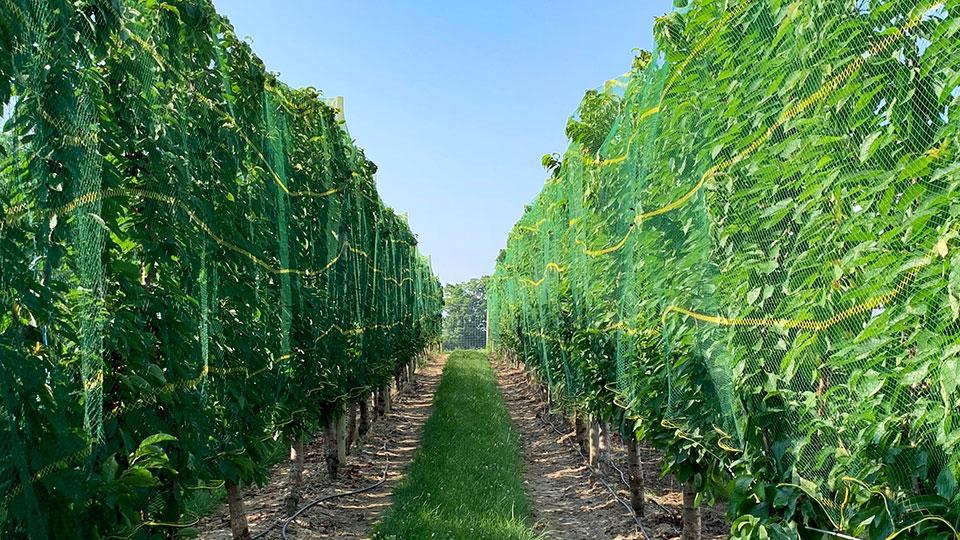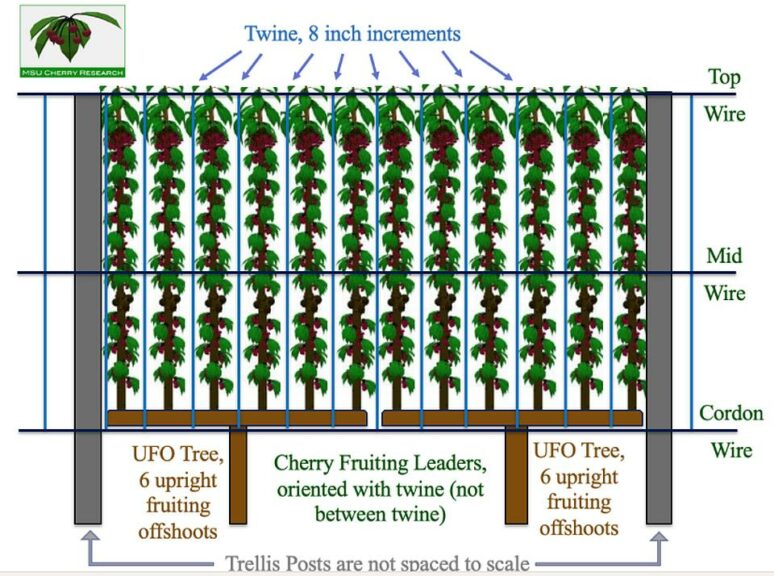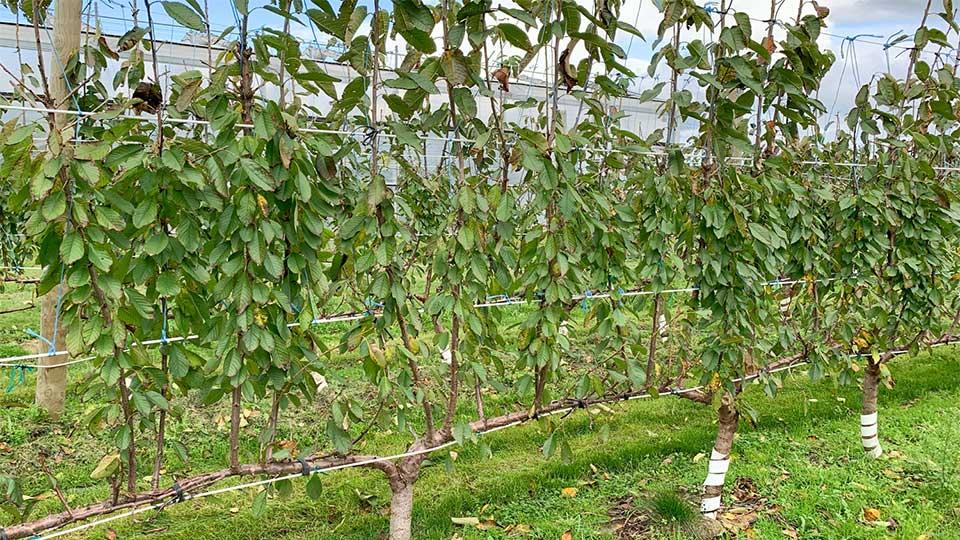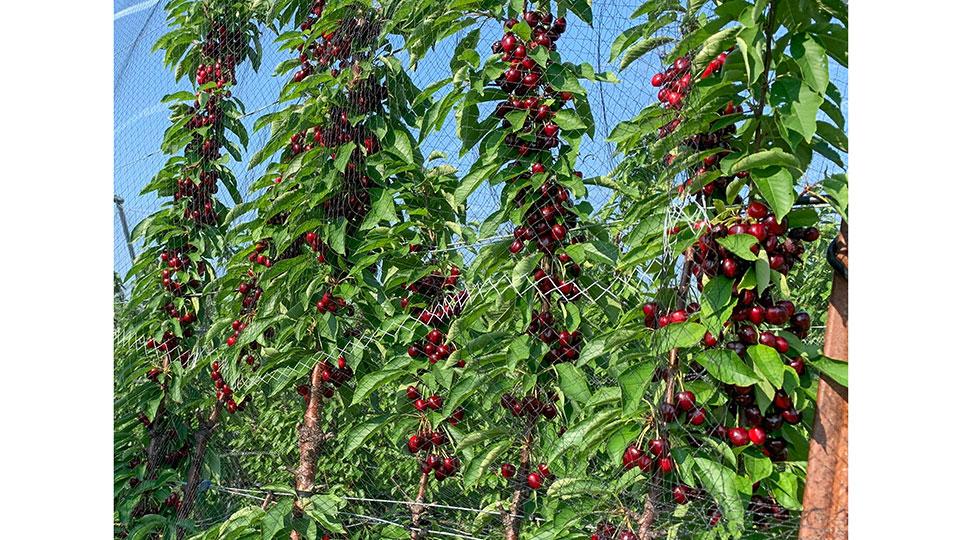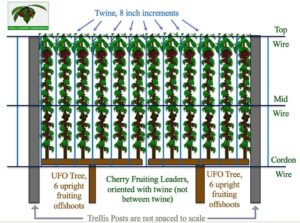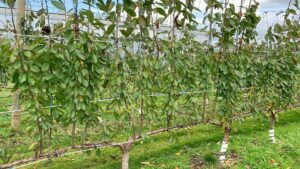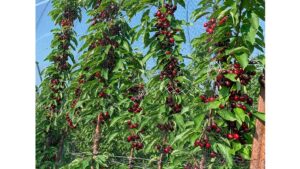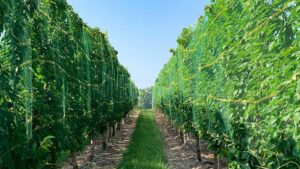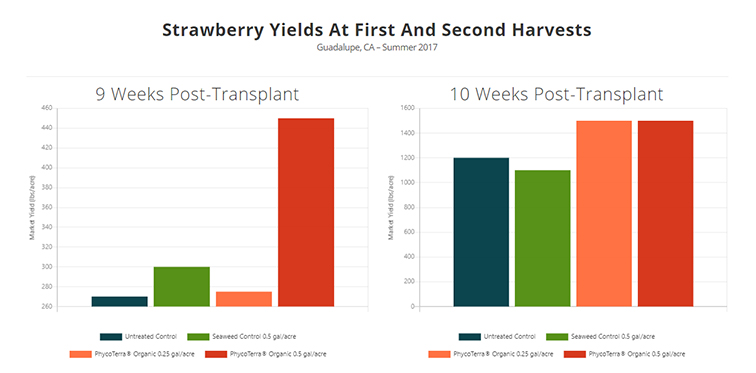Ways to Sharpen Your Sweet Cherry Production Systems With Precision
In my last column, we explored the contrasting challenges and benefits of the evolutionary growth and fruiting habit of sweet cherries, which are genetically “hard-wired” to not only produce very tall trees to survive in forests but also to develop a pattern of leaves that capture sunlight very efficiently for photosynthesis when the leader or shoots grow vertically.
This vertical growth is a highly efficient partitioning of growth resources (carbohydrates, nitrogen, other mineral nutrients) with minimal structural waste, since vertical growth could be thought of as the shortest, most efficient distance between two points. This vertical line of growth connects the soil (where mineral nutrients are acquired) to the full sunlight at the top of the forest (where the greatest amount of carbohydrates can be produced daily through photosynthesis). The Upright Fruiting Offshoots (UFO) and Kym Green Bush (KGB) canopy training systems harness these evolutionary growth efficiencies with multiple vertically oriented, unbranched leaders for bearing fruit.
So, this growth habit and light-capturing leaf pattern was Part 1 of the sweet cherry’s highly efficient use of growth resources for competition with neighboring forest trees. Part 2, concomitant with canopy growth, is the necessary diversion of some growth resources to the root system to develop and expand the capacity for “foraging” and capturing the water and mineral nutrients needed by the growing canopy, as well as anchoring the tree. The competition with other nearby trees for exploring the soil can be just as important as the above-ground competition for light interception. Yet diverting too many growth resources to the roots can limit the canopy’s ability to compete for and capture light.
Turn to Reproduction
As we strive to domesticate these traits of wild sweet cherry trees within an orchard setting, we utilize irrigation and fertilization to provide all the water and nutrients the tree needs. By doing so, the root system does not require as much carbon and nutrients for development as it would in a forest. Similarly, we utilize vigor-limiting rootstocks imbued with genetics that alter tree physiology such that the canopy extends less in the quest for light, reducing the need for growth resources for tree structure.
Horticulturally, we can thus shift some growth resources away from both canopy structure and root development. This leads to Part 3 of sweet cherry growth and survival — reproduction. Once the forest tree has “staked out” it’s spatial claims to light interception and water/nutrient resources, it begins diverting an increasing proportion of its growth resources to reproduction, generally between five and 10 years after emerging from the forest floor.
Here again, rootstocks can play a key horticultural role in taming the wild cherry’s evolutionary delay in fruiting. Grafting to rootstocks like those in the Gisela series can strongly promote precocity, the ability of the tree to begin forming flowers years earlier than would have occurred as a seedling in the highly competitive forest. In the orchard, we work to shift growth resources away from canopy and root growth as soon as we are sure the tree will fill its allotted space, and to reproduction (fruiting). This represents a physiological shift similar to that addressed in modern grain production by the terms “Harvest Index” or “Reproductive Efficiency” — essentially the amount of desirable yield relative to the amount of canopy and root structure required to support it.
Primary Challenge
Achieving an optimal arrangement of light-intercepting leaves with a minimal canopy structure, as well as an optimal balance of flowering sites relative to the number of light-exposed leaves available to support their development into large, sweet fruit, is the ultimate horticultural challenge. By deconstructing the tree canopy into relatively simplified and uniform vertical units, it becomes easier to quantify sun-exposed leaf area and fruiting sites and manage these units to achieve an optimized leaf area-to-fruit ratio, thereby harnessing precision as well as efficiency in orchard management!
With UFO canopy training, we can now define every square inch of potential vertical light-exposed leaf area by establishing a three-wire trellis for canopy support and uniform 8-inch fruiting unit sections delineated by vertical strands of twine tied at each wire for stability (Figure 1, see photo slideshow above). This grid helps assure that we fill as close to 100% of the fruit-producing canopy area as possible, and the twine provides a quick and easy way to precisely orient vertical shoot growth without time-consuming tie-downs or clips (Figure 2). By filling canopy space with vertical growth, it is relatively easy to fill inadvertent gaps at any age by shifting any low shoot into the gap and letting it grow the way the tree evolved to grow – vertically.
This precise development and simplification of fruiting units (Figure 3) results in the most efficient canopy structure for harvest, allowing the entire crop to be picked from one side of the tree, whether on the ground or a platform (or ladder). The time required per pound of fruit harvested by hand has been reported to be 40% less than that for three-dimensional spindle trees. Netting for bird protection by row (Figure 4) or using plastic row covers for rain protection is also simplified by the minimization of lateral branch growth. These advantages of evolutionary efficiency and precision management are also now being increasingly studied and utilized for other temperate tree fruits, such as apple, peach, plum, pear, and apricot.





